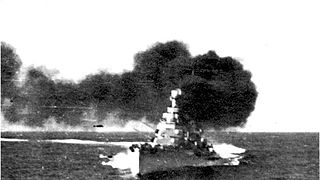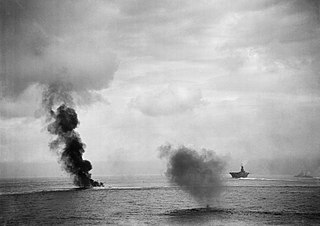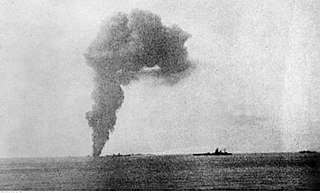 W
WThe Malta convoys were Allied supply convoys of the Second World War. The convoys took place during the Siege of Malta in the Mediterranean Theatre. Malta was a base from which British sea and air forces could attack ships carrying supplies from Europe to Italian Libya. Britain fought the Western Desert Campaign against Axis armies in North Africa to keep the Suez Canal and to control Middle Eastern oil. The strategic value of Malta was so great the British risked many merchant vessels and warships to supply the island and the Axis made determined efforts to neutralise the island as an offensive base.
 W
WOperation Bowery was an Anglo-American operation in World War II to deliver Spitfire fighter aircraft to Malta. The aircraft were desperately needed to bolster the island's defence against strong Axis air raids.
 W
WThe Battle of Calabria, known to the Italian Navy as the Battle of Punta Stilo, was a naval battle during the Battle of the Mediterranean in the Second World War. Ships of the Italian Regia Marina were opposed by vessels of the British Royal Navy and Royal Australian Navy. The battle occurred 30 miles to the east of Punta Stilo, Calabria, on 9 July 1940. It was one of the few pitched battles of the Mediterranean campaign during the Second World War involving large numbers of ships on both sides. Both sides claimed victory, but in fact the battle was a draw and everyone returned to their bases safely.
 W
WOperation Calendar in 1942 was an Anglo-American operation in World War II to deliver Supermarine Spitfire fighter aircraft to Malta. The aircraft were desperately needed to bolster the island's defence against strong Axis air raids.
 W
WThe Battle of Cape Spartivento, known as the Battle of Cape Teulada in Italy, was a naval battle during the Battle of the Mediterranean in the Second World War, fought between naval forces of the Royal Navy and the Italian Regia Marina on 27 November 1940.
 W
WClub Run was an informal name for aircraft ferry operations from Gibraltar to Malta during the Siege of Malta in the Second World War. Malta was half-way between Gibraltar to Alexandria and had the only harbour controlled by the British in the area. Malta had docks, repair facilities, reserves and stores, which had been built up since the cession of the island to Britain in 1814. Malta had become an important staging post for aircraft and a base for air reconnaissance over the central Mediterranean. The Axis powers Italy and Germany made several attempts from 1941 to 1942 to either force the British military authorities on the island to surrender or to destroy its effectiveness as a military base. The island was a forward base from which Axis supplies to their North African armies could be attacked. It is a measure of Malta's importance that Britain reassigned fighter aircraft from home defence.
 W
WOperation Excess was a series of British supply convoys to Malta, Alexandria and Greece in January 1941. The operation encountered the first presence of Luftwaffe anti-shipping aircraft in the Mediterranean Sea. All the convoyed freighters reached their destinations. The destroyer Gallant was disabled by Italian mines and Axis bombers severely damaged the cruiser Southampton and the aircraft carrier Illustrious.
 W
WOperation Halberd was a British naval operation that took place on 27 September 1941, during the Second World War. The British were attempting to deliver a convoy from Gibraltar to Malta. The convoy was escorted by several battleships and an aircraft carrier, to deter interference from the Italian surface fleet, while a close escort of cruisers and destroyers provided an anti-aircraft screen.
 W
WOperation Harpoon or Battle of Pantelleria was one of two simultaneous Allied convoys sent to supply Malta in the Axis-dominated central Mediterranean Sea in mid-June 1942, during the Second World War. Operation Vigorous was a westward convoy from Alexandria run at the same time Operation Harpoon was an eastbound convoy operation from Gibraltar. Two of the six ships in the Harpoon convoy completed the journey, at the cost of several Allied warships. The Vigorous convoy was driven back by the Italian fleet and attacks by Axis aircraft.
 W
WOperation Hurry was the first British operation in a series that have come to be known as Club Runs. The goal of the operation was to fly twelve Hawker Hurricanes from HMS Argus to Malta, guided by two Blackburn Skuas.
 W
WOperation MB8 was a British Royal Navy operation in the Mediterranean Sea from 4 to 11 November 1940. It was made up of six forces comprising two aircraft carriers, five battleships, 10 cruisers and 30 destroyers, including much of Force H from Gibraltar, protecting four supply convoys.
 W
WOperation Pedestal, known in Malta as Il-Konvoj ta' Santa Marija, was a British operation to carry supplies to the island of Malta in August 1942, during the Second World War. Malta was a base from which British ships, submarines and aircraft attacked Axis convoys to Libya, during the North African Campaign (1940–1943). From 1940 to 1942, the Axis conducted the Siege of Malta, with air and naval forces. Despite many losses, enough supplies were delivered by the British for the population and military forces on Malta to resist, although it ceased to be an offensive base for much of 1942. The most crucial supply item in Operation Pedestal was fuel, carried by SS Ohio, an American tanker with a British crew. The convoy sailed from Britain on 3 August 1942 and passed through the Strait of Gibraltar into the Mediterranean on the night of 9/10 August.
 W
WOperation Portcullis was the dispatch of Convoy MW 14 to Malta from Port Said. The convoy followed the success of Operation Stoneage which had raised the Siege of Malta. Four merchant ships were escorted to Malta by seven destroyers of the 12th Destroyer Flotilla, supported by three cruisers of the 15th Cruiser Squadron and three destroyers from Alexandria.
 W
WThe Second Battle of Sirte was a naval engagement on 22 March 1942 in which the escorting warships of a British convoy to Malta held off a much more powerful Regia Marina squadron. The British convoy was composed of four merchant ships escorted by four light cruisers, one anti-aircraft cruiser, and 17 destroyers. The Italian force comprised a battleship, two heavy cruisers, one light cruiser, and ten destroyers. Despite the initial British success at warding off the Italian squadron, the Italian Fleet attack delayed the convoy's planned arrival before dawn, which exposed it to intense air attacks that sank all four merchant ships and one of the escorting destroyers in the following days. The battle occurred in the Mediterranean Sea, north of the Gulf of Sidra and southeast of Malta, during the Second World War.
 W
WThe First Battle of Sirte was fought between the British Royal Navy and the Regia Marina during the Mediterranean campaign of the Second World War. The engagement, largely uneventful, took place on 17 December 1941, south-east of Malta, in the Gulf of Sirte.
 W
WOperation Stoneage or Operation Stone Age was an Allied convoy operation to the Mediterranean island of Malta in the Second World War. To disguise the destination of the ships, some took on their cargo at Port Sudan in the Red Sea. The four ships of Convoy MW 13 sailed from Alexandria on 16 November, escorted by cruisers, destroyers and round-the-clock air cover from captured airfields in Egypt and Cyrenaica.
 W
WOperation Substance was a British naval operation in July 1941 during the Second World War to escort convoy GM 1, the first of the series from Gibraltar to Malta. The convoy defended by Force H was attacked by Italian submarines, aircraft, and Motoscafo armato silurante.
 W
WOperation Vigorous was a British operation during the Second World War, to escort supply convoy MW11 from the eastern Mediterranean to Malta, which took place from 11–16 June 1942. Vigorous was part of Operation Julius, a simultaneous operation with Operation Harpoon from Gibraltar and supporting operations. Sub-convoy MW11c sailed from Port Said on 11 June, to tempt the Italian battlefleet to sail early, use up fuel and be exposed to submarine and air attack. MW11a and MW11b sailed next day from Haifa, Port Said and Alexandria, one ship being sent back because of defects. Italian and German (Axis) aircraft attacked MW11c on 12 June and a damaged ship was diverted to Tobruk, just east of Gazala. The merchant ships and escorts rendezvoused on 13 June. The British plans were revealed unwittingly to the Axis by the US Military Attaché in Egypt, Colonel Bonner Fellers, who reported to Washington, D.C. in coded wireless messages. The Black Code was later revealed by Ultra to have been broken by the Servizio Informazioni Militare.